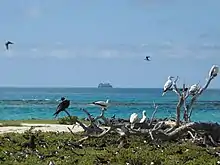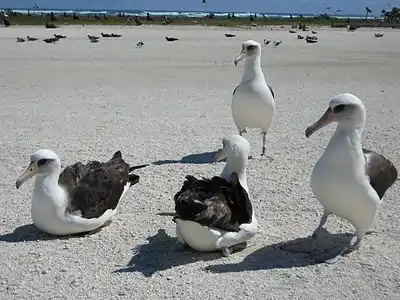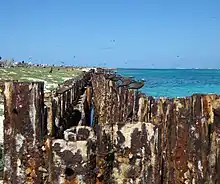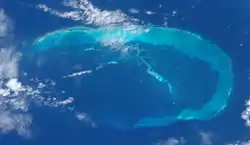Tern Island (Hawaii)
Tern Island is a tiny coral island located in the French Frigate Shoals in the Northwestern Hawaiian Islands, at 23.870°N 166.284°W, approximately 490 miles (790 kilometers) west north west of Oahu. It has a land area of 105,276 m2 (26.014 acres). The island provides a breeding habitat to 18 species of seabirds, threatened Hawaiian green sea turtles, and endangered Hawaiian monk seals.[1] It is maintained as a field station in the Hawaiian Islands National Wildlife Refuge by the United States Fish and Wildlife Service.


The island has an airstrip over the length of the island, built in 1942. This has supported use by the U.S. Navy, Coast Guard, and wildlife services since that time, and various types of operations have been conducted from this location which is host to limited facilities for habitation.
The US Fish & Wildlife service closed its field station on the island at the end of 2012.[2] There was a Naval base from 1942 to 1946, a Coast Guard Base from 1952 to 1979, and finally a Fish & Wildlife station from 1979 to 2012.
History
_(19722865924).jpg.webp)
.jpg.webp)

.jpg.webp)
The atoll is home to an airstrip created in 1942-3, and was later used by the Coast Guard.[4] During WW2 nearly 130 staff manned the island, while the later wildlife station had between 5-15 staff on Tern.[5]
After the Battle of Midway in the summer of 1942, the U.S. Navy built a Naval Air Station on Tern Island, enlarging the island sufficiently to support a 3300 ft. (1005 m) landing strip. The station's main function was as an emergency landing site for planes flying between Hawaii and Midway Atoll. The original seawall, runway, and some of the buildings remain.
Construction on the island started in July 1942 and the facility was commissioned in March 1943 as a Naval Air Station.[6]
The base was meant to stop the Japanese using the atolls to attack mainland Hawaii, as had happened during Operation K. The island was increased from 11 acres to 34 acres, and there was parking spots for 22 aircraft.[7] There was a 90 feet tall radar tower also and barracks for the island's crew.[8] Air patrols were flown from Tern island to do reconnaissance in this region.[9]
The base was had some defenses during WW2, including a battery of 90 mm guns, 3-inch guns, and also numerous .30 cal machine guns emplacements.[10] Having survived the battle of Midway, the base on Tern island served as a stopping point for aircraft flying between Midway and the main Hawaian islands, such as for refueling or emergency landings.[11]
One extraordinary emergency landing occurred in 1944, when a Curtis Commando with dozens of marines had an engine failure and was close to ditching in the ocean.[12] The twin-engine transport plane was down to an altitude of less than 300 feet, despite having ditched as much weight as feasible when it managed to land on Tern island.[13] The aircraft was able to land with one engine out, and no lives were lost.[14]
In 1945, Tern island hosted the USMC comedy show "All Fouled Up" when the entourage's R4D aircraft could not land at Midway due to fog.[15] The show was performed at Tern island, and the group went on to Midway later.[16] The show did a two month long tour at US Pacific bases.[17]
The naval base operated from 1942 to 1946, and a U.S. Coast Guard station operated from 1952 until 1979.[18] In 1969, a tsunami wiped out much of the station, and it had to be repaired.[19]In 1969, when the island was inundated with water, the crew was evacuated by helicopter by the ship HMS Waikato, and taken to Midway.[20]
In 1946 two fisheries were established on Tern island, and they flew out fish to Honolulu on a DC-3 aircraft.[21]
From 1961 to 1983 there was also a missile tracking station on Tern island.[22]
Between 1986 and 1991 Tern Island was used to study the Green Turtle (Chelonia mydas).[23]
A Piper Aztec has landed over 600 times at Tern Island.[24] There are typically monthly flights to Honolulu for mail, and heavier cargo usually comes by water.[25] An alternative is email, either by satellite phone or the island's broadband internet connection.[25]
The old U.S. Coast Guard barracks continued to be used into the 21st century.[24] Upgrades include the cleanup of old waste, improved water tanks, and solar power.[18] The solar power runs a reverse osmosis water maker, capable of producing 1200 gallons a day.[18] There is also a diesel generator with a 500-gallon fuel tank.[18]
In the summer of 2004, 1200 feet of seawall was repaired with a new design, and the old boat dock was replaced by boat ramp for small boats.[26] However, thouands of feet of seawall was still in need of repair.[27]
A Fish and Wild Life field station was active at the island from 1979 to 2012.[28] The closure came after a storm in December 2012, when several people evacuated from Tern island in advance of a severe storm.[29] The storm damaged some of facilities on the island including the barracks.[30][31] The US Fish & Wildlife service closed its field station on Tern island at the end of 2012.[32]
In 2013, the island was imaged for a Google Street View project, to allow the islands to viewed online in a special viewer.[33] Google and the US Government worked to make 5 islands of a National Pacific nature reserve viewable as part of this project.[34] The other islands in the Pacific surveyed for the program included East Island (also in the French Frigate Shoals), Laysan Island, Lisianski Island, and Pearl and Hermes Atoll.[35] The online viewer allows a series of panoramic images from head height to be viewed a course around the island.[36] The path takes views along much of the length of the airstrip and along part of the shore.[37]
In 2013 the NOAA ship Oscar Sette visited the French Frigate Shoals, and tent field camp was setup on Tern island.[38] The storm at the end of 2012 had left the existing barracks uninhabitable, and the water system also not usable.[39] Water had to be brought to the island in jugs from boats on this expedition.[40] The goods for the expedition were offloaded from small boats at the Tern island dock.[41]
In 2019, a full survey of green sea turtles on Tern island was conducted by biologists.[42] 371 green sea turtles were found on the island.[43]
In 2020, the beach at Tern island was designated as an environmentally polluted by plastic trash.[44] This ruling came after years of research at the site, including 14.5 thousand kilograms of trash within 5000 meters of the beach over 11 years.[45] Of this debris over 70 percent of the trash was plastic, which has become a point of concern on these Pacific islands.[46] The nature of how debris from the sea accumulates on Tern island was studied in the 2010s.[47]
In 2020, the Papahanaumokuakea Marine Debris Project removed tens of thousands of pounds/kg of debris from the French Frigate Shoals, including Tern island.[48]
Birds


The use of Tern island by birds has been studied.[49] Once concern is birds eating plastic trash, which was studied at Tern island between 2006 an 2013.[50] Tern island is a popular place for researchers to study Pacific sea and land birds.[51]
There are about sixteen (16) Seabird species seen at Tern island in the early 21st century.[52]Some of the birds species found at Tern island include:[53] [54]
- Sooty terns
- White terns
- Brown noddies
- Black noddy
- Masked boobies
- Brown boobies
- Red-footed boobies
- Wedge-tailed shearwater
- Tristram's storm petrel
- Black-footed albatross
- Laysan albatross
- Great frigatebird
In 1998 and 1999, the Black-footed albatross (Phoebastria nigripes) and Laysan albatross (Phoebastria immutabilis) were studied at Tern island.[55] The research recorded a particularly unsuccessful nesting season for the Albatrosses.[56]
In 2010 a study of birds noted that other rare birds sometimes are seen at Tern also.[57] Examples of birds rarely seen at Tern island include a Short-eared Owl (Asio flammeus) and Fork-tailed Swift (Apus pacificus).[58]
Tern island also became popular with Green Sea Turtles; in 1977 there were no nests on the island, but twenty years later this grew to 700 nests.[59]
Some of the migratory shorebirds known to overwinter at Tern in the early 21st century include:[60]
- Pacific Golden Plover (Pluvialis fulva)
- Ruddy Turnstone (Arenaria interpres)
- Sanderling (Calidris alba)
- Wandering Tattler (Heteroscelus incanus)
- Bristle-thighed Curlew (Numenius tahitensis)
Seawall

During WW2 in response the Japanese use of the atolls and to provide a link with Midway, the island was expanded to allow for a landing strip.[61] The island was protected from the surf by 5000 feet of double steel pylon sea wall, with walls separated by 4 feet (over 1 meter) which was finished in 1943.[62] The original WW2 sea wall is composed of over 5000 steel pilings.[63] Maintenance on the wall was further conducted by the U.S. Coast Guard between 1952 to 1979.[64]
In 2000/1 the United States Congress approved 10 million USD to repair the island.[65]
In 2004, the Fish & Wild Life service did a 12 million dollar project to repair the seawall and some other maintenance on the island.[66] This project repaired 1200 feet of seawall.[67] The project was managed by the U.S. Army Corp Engineers.[68]
Geography
Some of the beaches on the island include:[69]
- Shell Beach & Crab Beach, on the north side of the island
- East Beach
- South Beach
There is a small boat ramp since 2004, which replaced dock and boat hoist.[70]
See also
- French Frigate Shoals Airport
- Desert island
- List of islands
References
- Good. "Tern Island Preliminary Assessment and Technical Support Document". Retrieved 2017-04-18.
- ECHNICAL SUPPORT DOCUMENT TO THE PRELIMINARY ASSESSMENT OF THE FWS – HAWAIIAN ISLANDS NATIONAL WILDLIFE REFUGE: TERN ISLAND SITE IN THE FRENCH FRIGATE SHOALS, HAWAIʻI
- Population Dynamics of Hawaiian Seabird Colonies Vulnerable to Sea-Level Rise on Page 4.
- ECHNICAL SUPPORT DOCUMEN T TO THE PRELIMINARY ASSESSMENT OF THE FWS – HAWAIIAN ISLANDS NATIONAL WILDLIFE REFUGE: TERN ISLAND SITE IN THE FRENCH FRIGATE SHOALS, HAWAIʻI
- ECHNICAL SUPPORT DOCUMENT TO THE PRELIMINARY ASSESSMENT OF THE FWS – HAWAIIAN ISLANDS NATIONAL WILDLIFE REFUGE: TERN ISLAND SITE IN THE FRENCH FRIGATE SHOALS, HAWAIʻI
- Coral Carrier Binson
- Coral Carrier Binson Page 105
- Coral Carrier Binson Page 105
- Coral Carrier Binson Page 105
- Coral Carrier Binson Page 105
- Coral Carrier Binson Page 105
- Coral Carrier Binson Page 105
- Tern Island
- LORAN Station French Frigate Shoals
- Reproductive biology of the green turtle (Chelonia mydas) at Tern Island, French Frigate Shoals, Hawai`i
- Heart of the sanctuary
- Tern Island - at Work
- Biologists Evacuated from Remote Pacific Field Station
- ECHNICAL SUPPORT DOCUMENT TO THE PRELIMINARY ASSESSMENT OF THE FWS – HAWAIIAN ISLANDS NATIONAL WILDLIFE REFUGE: TERN ISLAND SITE IN THE FRENCH FRIGATE SHOALS, HAWAIʻI
- A Virtual Tour of the Northwestern Hawaiian Islands
- Community-wide patterns of plastic ingestion in seabirds breeding at French Frigate Shoals, Northwestern Hawaiian Islands
- 4.2.2.2.1 Nesting Species on Tern
- [https://www.fws.gov/fieldnotes/regmap.cfm?arskey=14792&callingKey=state&callingValue=HI Tern Island Seawall Reconstruction Protects Wildlife Habitat and Monitoring Station Pacific Region, July 1, 2004]
External links
- Ternisland.com
- Tern Island: Noah's Ark of the Hawaiian Isles
- Satellite View
- Google Street View July 2013
- Visible Earth
- Naval History YHB-10 (Used as barracks during WW2 at Tern island)

